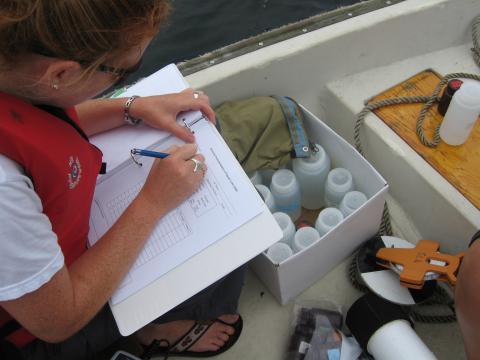
The Center for the Environment is engaged in a number of research projects. Our work focuses on environmental science. Our projects involve high quality research that serves our region. To help meet this goal, we routinely work with partners, both on- and off-campus, to define ways in which our work can help address regional issues.
Conservation Ecology & Sustainability
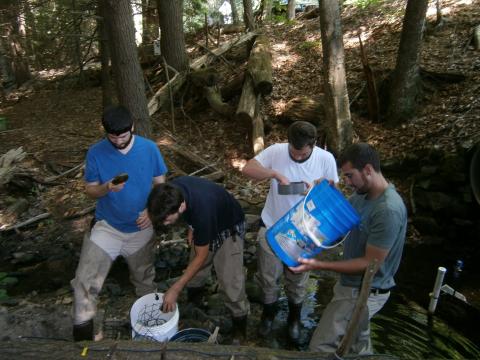
Over time the use of chloride salt control products for winter conditions (i.e. deicers) has caused growing concern over environmental impacts to nearby ecosystems, with gradual increases in overall salinity becoming present over extended periods of time. This trend holds potential negative consequences for freshwater resources and ecosystems throughout NH and the U.S. This project is designed to assess the impacts of highway and road maintenance as well as land use, development, and storm water runoff on surface water quality and freshwater biota. We focus on the effects of chloride and stream temperature on stream biota, using benthic macroinvertebrates as eco-indicators of ecological stress. In this project, we take a multi-level approach to evaluate ecological stress in New Hampshire streams at the community, population, and molecular levels. This project has five main components: (1) field sampling of macroinvertebrates to provide community and population metrics of ecological response, (2) laboratory-based stress experiments to determine heat shock protein (HSP) induction thresholds for thermal-salt stress in two mayfly genera, (3) field sampling and HSP expression assays of mayfly nymphs from streams that span a thermal and salt gradient to determine the utility of HSPs as biomarkers of stress in wild populations of mayflies, (4) continuous monitoring of conductivity, water level, temperature (stream and air), and (5) snapshot water chemistry (anion and cation) sampling to coincide with macroinvertebrate sampling. This research team is led by Dr. Villamagna (Environmental Science and Policy Dept) and Dr. Brigid O’Donnell (Biology Dept).
This research team included Environmental Science and Policy graduate students Matthew Mazzone (’17) and Roy Fruit (’17) and Environmental Science and Policy undergraduates Ryan Duquette (’17) and Thomas Lafortune (’17). This project is funded by New Hampshire Water Resources Research Center – USGS NIWR and Plymouth State University.
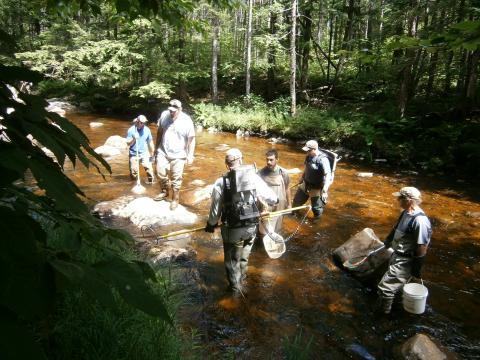
The Beebe River is a tributary to the Pemigewasset River (New Hampshire) and the Merrimack River (New Hampshire & Massachusetts further downstream). Five of the seven tributaries that feed the mainstem are impacted by undersized road crossing and water temperature in the mainstem during late summer months is hypothesized to limit the presence of EBT. This program is multifaceted, focusing on habitat improvement and wildlife population monitoring. The research program, established in Summer 2016 in collaboration with NH Fish and Game Dept, The Conservation Fund, and the Pemigewasset chapter of Trout Unlimited, was developed to monitor freshwater and riparian ecological conditions and assess culvert replacement efforts on the wild Eastern brook trout population, as well as other coldwater fish and macroinvertebrates. The project blends an array of continuously logging environmental sensors for air and stream temperature, stream stage, and specific conductance and wildlife cameras focused on pools with snapshot water sampling, fine-scale in-stream habitat and riparian zone assessment, macroinvertebrate sampling, and electroshocking and tracking of wild brook trout. This research team is led by Dr. Villamagna (Environmental Science and Policy Dept) and Dr. Brigid O’Donnell (Biology Dept). Funding and support for this project comes from Plymouth State University Cluster Initiative, NH Fish & Game Dept, The Conservation Fund, and Trout Unlimited-Pemi Chapter.
This research team included Dr. Amy Villamagna (Environmental Science & Policy), Dr. Brigid O’Donnell (Biology), Tyson Morrill (Biology graduate student ‘18), Nick Schola (Interdisciplinary Studies undergraduate student ’19), Griffin Nyhan (ESP undergraduate ’20), and Zach Newcity (ESP undergraduate ’18).
This project addresses several high-priority challenges including enhancing the performance and accessibility of roads for alternative modes of transportation, promoting sustainability, increasing alternative modes of mobility by residents and tourists, and preparing for a future that promotes environmental, social, and economic well-being in a growing New Hampshire. This project in conducted in close collaboration with partners from the Bike Pedestrian Technical Advisory Committee, NH Healthy Eating Active Living program, Bike – Walk Alliance of NH, and representatives from prominent regional planning commissions (Central NH and Nashua). This project leverages (a) existing datasets (participatory mapping of facility activity through the Strava App), (b) statewide on-the-ground bike-ped monitoring initiatives (conducted in partnership with the 9 regional planning commissions in NH), (c) the development and application of a spatially explicit Level of Traffic Stress (LTS) model for bicycling. It incorporates novel public participatory GIS approaches to assess patterns of current bicycle activity and identify potential barriers to access and participation. In the next year, this project will focus on (1) evaluating Level of Traffic Stress along common bicycling routes, as noted by Strava, and along routes to and from key community destinations, (2) validating and revising as needed the LTS model and GIS tool, and (3) assess impacts to LTS and observed bicycling potentially attributed to road paving and construction. This project is led by Dr. Amy Villamagna (Environmental Science and Policy) and is funded by New Hampshire Department of Transportation.
This research team included Dr. Amy Villamagna (Environmental Science and Policy), Laura Getts (graduate student Environmental Science and Policy ’17), Raegan Young (Environmental Science and Policy undergraduate ’19), and Laura Harrington (Environmental Science and Policy undergraduate ’19).
Hydrometeorology Research
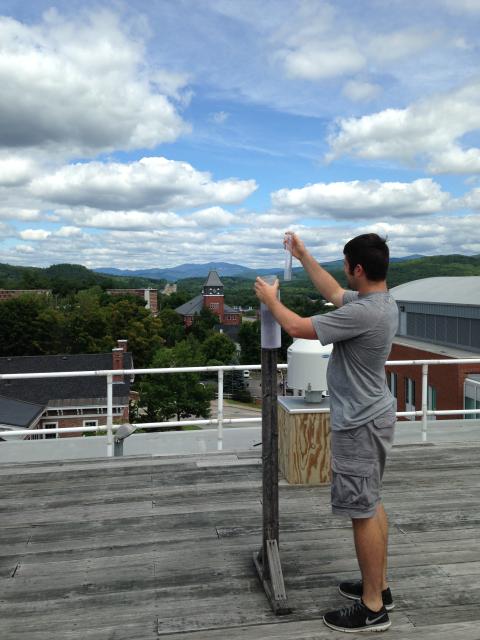
The ability to observe and predict hydrometeorology extremes associated with heavy precipitation and floods is crucial in our ability to understand the water cycle and provide advance warning to potentially hazardous situations. Heavy precipitation influences ecosystems, agriculture, infrastructure and water resources, thus impacting society. One of the most costly effects of heavy precipitation is flooding; floods caused more loss of life and property damage than any other natural disaster in the U.S. between 1900 and 1999. Damages from high streamflow events and/or flooding include, but are not limited to, loss of life, damage to infrastructure (e.g., buildings, roads, culverts), erosion and pollution from storm runoff (e.g., suspended solids, mobilization of metals). The ability to provide advanced flood warning can mitigate as much as one third of all residential damages.
Understanding hydrometeorology extremes require interdisciplinary knowledge of atmospheric and hydrologic processes. This knowledge is acquired through coursework at PSU in the MS and BS programs in Applied Meteorology and BS program in Environmental Science and Policy, along with applied research and observations in regions susceptible to such extremes. Ongoing work at the Center for the Environment seeks to better understand hydrometeorology extremes across the United States and in New England. Specific projects and activities include:
- Developing forecasts of atmospheric water vapor transport in order to better anticipate orographic (mountain-influenced) precipitation extremes
- Participating in airborne field projects to better observe atmospheric water vapor transport
- Researching the relationships between atmospheric water vapor transport, floods, and flash floods
- Investigate the evolution of atmospheric flow patterns prior to periods of precipitation extremes
- Developing methods and tools to provide forecast-informed reservoir operations
- Modeling historic precipitation extremes
Hydrology Research
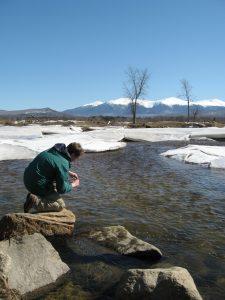
The White Mountains of New Hampshire are the headwaters of the Connecticut, Merrimack, Saco, and Androscoggin Rivers. The Center for the Environment is involved with several research projects related to understanding the hydrology of the region. Associate professor Mark Green led this work in the past. A primary interest is understanding how water transport controls biogeochemical and ecological processes, and vice versa. Research in this area includes a series of analyses focused on synthesizing and advancing our understanding of how hydrologic functions recover after forest disturbance. A primary research site for this work is the Hubbard Brook Experimental Forest. Work in this arena is primarily funded by the Northern Research Station of the U.S. Forest Service; other funding comes from the U.S. National Science Foundation, the Japanese-U.S. Education Commission, and the White Mountain National Forest.
Specific projects include:
- Monitoring stable isotopes of water throughout the Hubbard Brook valley
- Understanding the hydrologic implications of forest nutrition
- Quantifying uncertainty in watershed water and nutrient budgets
- Aluminum mobilization in streamwater after forest harvests
- Spatial and temporal monitoring of water in the Pemigewasset River watershed
- Measuring evapotranspiration in the Hubbard Brook Experimental Forest
- Understanding flow paths and implications for water chemistry, runoff, and mapping drainage networks (with particular interest in identifying perennial, intermittent and ephemeral streams) using enhanced topographic data (LiDAR) and results of studies at Hubbard Brook Experimental Forest
Land Use Planning
People and the environment are central to our mission and one way in which they come together is through land use planning. Many land use decisions are made locally by our Planning Boards and these decisions shape our communities. The CFE's former Associate director June Hammond Rowan’s research focused on understanding these boards and the decisions they make. A goal of this work was to help improve long-range, comprehensive land use planning when making short-term decisions about development.
CFE is working with the Squam Lakes Association and other partners on developing a new Squam Lakes Watershed Plan. PSU graduate students have assisted with public meeting facilitation, interviewing stakeholders, surveying visitors to the region, and comparing watershed modeling tools for application in the Squam Watershed.
Analysis of Master Plans and Land Use Regulations
Land use and development are shaped by the plans and decisions made at the local level by municipal Planning Boards. Master Plans are created and adopted by these boards and serve as a comprehensive, forward looking policy statement to guide the overall character, physical form, growth, and development of a community. We are working on a comprehensive analysis of Master Plans in New Hampshire in order to determine how communities are addressing possible future changes in the natural and built environments and related impacts on the population. In 2017-2018 we expanded this work to to determine how communities are addressing stormwater impacts in land use planning process to determine successes and gaps in protecting both the quality and quantity of our water resources.
Avian Ecology
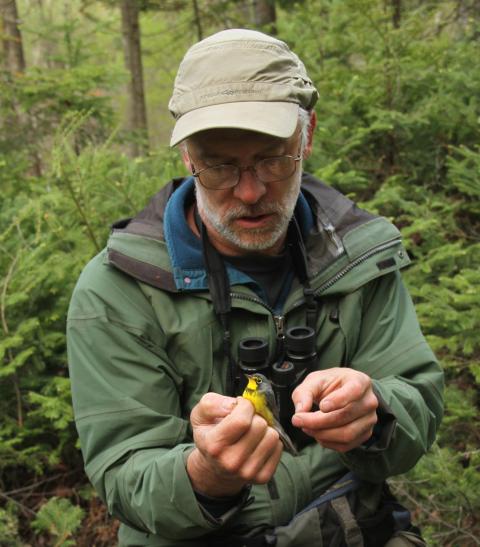
Since 2003, Len Reitsma has researched Canada Warblers working with students and collaborators to characterize its habitat preferences, nest site selection, age-related reproductive success, and, more recently, the genetic structure of the population and the connectivity of breeding and overwintering populations. The latter two involve collaborators at the University of Georgia and Environment Canada and involve analyses of feather isotopes and microsatellite markers to discern differences in genetic structure across the entire breeding range of the species.
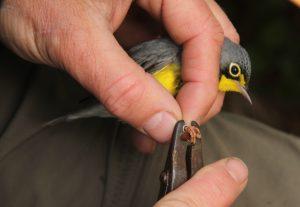
A second ongoing project monitors the bird community response to experimental patch cut harvesting on an American Tree Farm owned by Len and his family. Thus far, the small patch cuts of 0.5-1.0 acre have attracted early-succession species of birds without negatively affecting forest interior species’ abundance or reproductive success, and this was the intended response. This project will be ongoing for at least the next several years.
Len has also had graduate students in the last few years investigate the effects of wind power installations on sensitive bird species, the overwinter ecology of migratory bird species in the Neotropics, and the decline of breeding grassland bird species in northern New England. The common theme is the focus on migratory bird species and working at the population level.
Squam Lakes Contaminants
Plymouth State University’s Center for Environment (CFE), the Loon Preservation Committee (LPC), and the Squam Lakes Association (SLA) are partnering to help share information about recent findings of environmentally-significant levels of persistent organic pollutants (POP) in sediments of certain streams draining into Squam Lake. A report released by LPC in 2017 showed that three of their sampled sites contained environmentally-significant levels of PCBs and that two of those also had elevated levels of DDT and degradation products. Previous analysis of unhatched loon eggs showed presence of significant levels of PCBs, dioxins, flame retardants, stain guards, and pesticides (DDT and chlordane).
Our goal is to provide best available, balanced information. Below are several resources:
- Loon Preservation Committee Report: Contaminated Sediments in Squam Lake Tributaries, 2015-2016
- Squam Contaminants Meeting on 11/1/2017 at PSU

